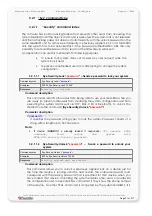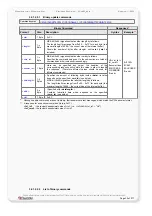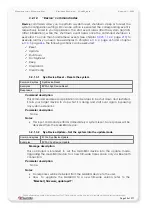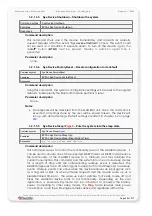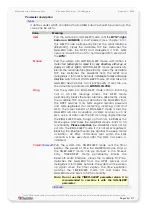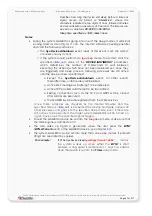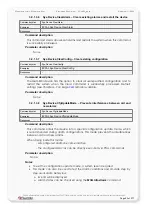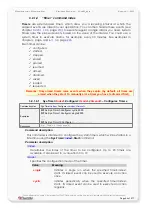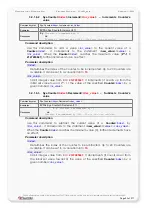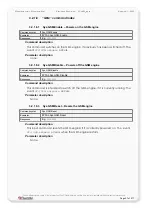
C
ONFIGURATION
C
OMMAND
S
ET
- F
IRMWARE
R
EVISION
2.4.0_
BETA
-
V
ERSION
1.0.0
<timeout>
32-bit integer value from
0
to
2147483647
. Determines the amount of time, in
milliseconds, on which the specified
Timer
runs. Each time the specified
timeout passes, the corresponding Timer event occurs.
Notes
•
Use caution when using cyclic timers in combination with a very small timeout
value. Always keep an eye for the execution time of alarms which are
executed upon this timer event (i.e. periodical SMS cannot be sent faster
than each 10 seconds. So, timers with very short time intervals will only slow
down the system performances)
•
The accuracy of system timers is approx. 200 ms. Therefore, a 0 value of
is valid, however the timer will be called every 200 milliseconds.
•
If a
Timer
is currently running, and this command is executed, the
running timer will be stopped. To activate/start it use the “
SYS.Timer
0
.Start
”
command.
3.2.1.4.2
Sys.Timer<
index
>.Start=<
timer_settings
>– Starts/restarts Timers
Command syntax
Examples
$PFAL,Sys.Timer
0
.Start
$PFAL,Sys.Timer
0
.Start=cyclic,2000
$PFAL,Sys.Timer
0
.Start=single,2000
Responses
E.g.
$Timer 0 started
OR
$Timer 0 initialized and started
Command description
This command is intended to start a configured timer or to restart a stopped timer.
System timers can be used to activate/execute delayed alarms. Timers can be
set/configured to automatically activate system actions at specific times. The
is optional
*
. It consists of the
and
values. Using the
, the
Timer
can be (re)configured and (re)started at once
without using the
$PFAL,Sys.Timer
.Configure
command, otherwise, if
is omitted, the
Timer
has to be configured before it starts.
Parameter description
<index>
Determines the index of the timer to be started. Up to 20 Timers are available. It
can be set to a value from
0
to
19
.
<timer_settings>
This parameter is optional. It can be used to start an un-configured timer or to
overwrite the existing settings by the new one. It consists of the
and
parameters which can be set the same as by the
Sys.Timer<
. If this parameter is used, the syntax of this command
looks like this:
Command syntax
PFAL,Sys.Timer<
<mode>
It specifies the timer’s task to be performed. Use it to perform an action
either periodically or just once. It can be set to:
single
Performs a single execution. it allows an action to be performed
just once.
This confidential document is a property of FALCOM and may not be copied or circulated without previous permission.
Page 45 of 271

